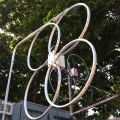G8JNJ
About
- Username
- G8JNJ
- Joined
- Visits
- 4,661
- Last Active
- Roles
- Member
- Points
- 130
Reactions
-
More GPS Problems - Damaged hardware?
Hi Chris,
I use passive satellite TV splitters with an inbuilt DC block (or steering diodes) on all but one port.
This sort of thing with suitable adaptors.
I use a two way to feed two more two ways, so that I can feed the office and workshop (Trimble) with a mid point split, This gives about about 7-8dB loss in total on each leg, which is fine with an antenna with 40dB of amplification.
Regards,
Martin - G8JNJ -
TDoA background maps not loading
>
>John, is it possible to have the basic (landmass boundaries) maps that TDoA used when I first got my Kiwi last summer?
>Presumably the multiple TDoAs I do when I TDoA in order to see the results "group" requires the same map tiles be loaded that many >times. I'm only interested in the coordinates. Landmass boundary maps I'm guessing might not have that problem... but then what do I >know?
>
Brett's suggestion is a good one.
I use the TDoA function a lot, and I'm concerned about the costs to John associated with the provision of maps.
Maybe have the option for no map, just the co-ordinates overlay, then once you have got a good plot you can re-run it with the required map turned on. This would save downloading tiles and additional cost.
Regards,
Martin - G8JNJ -
Advice on sharing RX antennas with 3 SDRs in the most effective way
Be careful regarding some of the commercial active splitters. Their IMD performance is not that good as they often use MMIC chips that can only achieve modest performance.
For example the Elad unit specifies an output IP3 of >24dBm, which is not particularly good, and would be typical of something using a PGA-103+ or similar as the active device which will provide an IMD performance of around an IOP2 of +50dBm and IOP3 of +30dBm.
My suggestion would be to use something like the DX Engineering RPA-1 followed by a Mini-Circuits splitter.
I've built a copy of the RPA-1 and it works well from about 10KHz to 40MHz and I have measured the IMD performance as an IOP2 of +92dBm and IOP3 of +45dBm.
Details are on my Active antennas web page.
https://www.g8jnj.net/activeantennas.htm
For GPS splitting you can use active L-Band splitters that were originally designed for distributing satellite TV services.
https://cpc.farnell.com/global-communications/split4af/4-way-active-splitter/dp/SE00009
I used this one but modified by cutting some tracks and adding an internal regulator so that it provided +5v out to feed the GPS antenna
Regards,
Martin - G8JNJ -
SAQ 17.2KHz - 30th June 2019
Good signals into the UK this morning from SAQ on 17.2KHz using an historic alternator transmitter
https://alexander.n.se/?lang=en
15dB above the noise floor into Farnham WEB SDR http://farnham-sdr.com/ in SE UK
12dB above the noise floor into Kernow KiWI WEB SDR http://kernow.hopto.org:8073/ at Goonhilly Earth Station in Cornwall SW tip of UK (despite a very high noise floor)
Unfortunately too much switched mode power supply noise on my SWUK KiWi SDR http://southwest.ddns.net:8073/ which masked the SAQ signal.
Another transmission due later today at 13.30 (11.30 UTC) the alternator starts and at 14.00 (12.00 UTC) will be broadcasting a message
Martin G8JNJ (Admin for Farnham / Kernow and SWUKSDR) -
SAQ 17.2KHz - 30th June 2019
Good signals into the UK this morning from SAQ on 17.2KHz using an historic alternator transmitter
https://alexander.n.se/?lang=en
15dB above the noise floor into Farnham WEB SDR http://farnham-sdr.com/ in SE UK
12dB above the noise floor into Kernow KiWI WEB SDR http://kernow.hopto.org:8073/ at Goonhilly Earth Station in Cornwall SW tip of UK (despite a very high noise floor)
Unfortunately too much switched mode power supply noise on my SWUK KiWi SDR http://southwest.ddns.net:8073/ which masked the SAQ signal.
Another transmission due later today at 13.30 (11.30 UTC) the alternator starts and at 14.00 (12.00 UTC) will be broadcasting a message
Martin G8JNJ (Admin for Farnham / Kernow and SWUKSDR)






